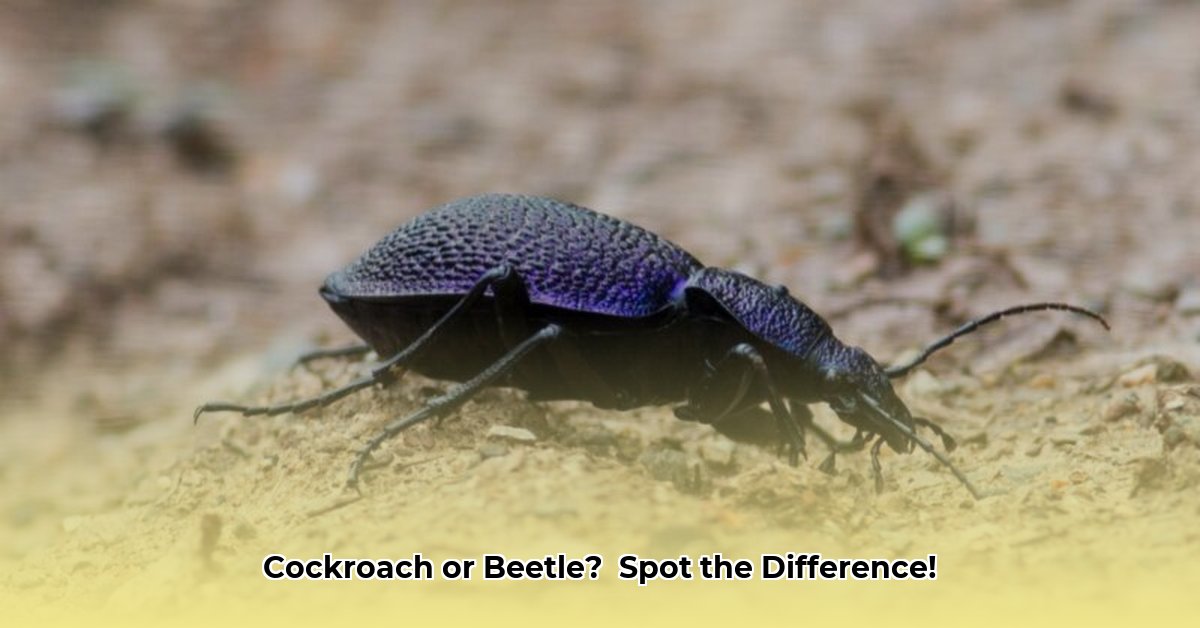Ever had that heart-stopping moment when something dark darts across your floor and you think “COCKROACH!”? Turns out, it might have been a totally harmless beetle. Many beetles look surprisingly like roaches, leading to unnecessary panic and even the killing of beneficial insects. This guide will help you tell the difference. We’ll explore common beetle “imposters,” learn their distinguishing features, and empower you to make informed decisions about pest control.
Beetle Imposters: Common Roach Look-Alikes
Several beetle species bear a striking resemblance to cockroaches, leading to frequent misidentification. Let’s explore some of the usual suspects:
Ground Beetles: The Garden Guardians
Often mistaken for roaches due to their dark coloration and quick movements, ground beetles are actually beneficial predators. Unlike roaches, they have distinct, segmented antennae and hard wing covers (elytra) that meet in a straight line down their back.
- Size Range: Highly variable, from a few millimeters to several centimeters.
- Distinguishing Features: Segmented antennae, hard elytra meeting in a straight line, often iridescent.
- Habitat and Range: Found in various habitats worldwide, often under rocks or leaf litter.
- Behavior: Nocturnal hunters of other insects.
- Ecological Role: Important predators, helping control pest populations.
Wood-Boring Beetles: The Silent Destroyers
These beetles can trigger roach alarm bells due to their size and reddish-brown color. However, their cylindrical body shape and the telltale small, round holes they leave in wood distinguish them from roaches.
- Size Range: Varies greatly depending on the species, from a few millimeters to several centimeters.
- Distinguishing Features: Cylindrical body shape, often reddish-brown, evidence of wood boring.
- Habitat and Range: Found wherever suitable wood is present, including homes and forests.
- Behavior: Larvae bore into wood, adults are less commonly seen.
- Ecological Role: Can be pests of wooden structures but also play a role in wood decomposition.
Drugstore Beetles: The Pantry Pirates
These small, reddish-brown beetles can be found in pantries, infesting stored products. Their distinctive clubbed antennae and striated wing covers differentiate them from cockroaches.
- Size Range: 2-3 mm.
- Distinguishing Features: Clubbed antennae, striated wing covers.
- Habitat and Range: Found worldwide in stored products like grains, spices, and dried herbs.
- Behavior: Infest and consume stored products.
- Ecological Role: Can become a pest in pantries but also contribute to nutrient cycling in natural environments.
Cigarette Beetles: The Tobacco Lovers
Similar to drugstore beetles, cigarette beetles share a reddish-brown hue but have shorter, serrated antennae. They infest dried goods, including tobacco.
- Size Range: 2-3 mm.
- Distinguishing Features: Short, serrated antennae.
- Habitat and Range: Found globally, infesting dried goods including tobacco, spices, and dried flowers.
- Behavior: Feed on dried plant material.
- Ecological Role: Can be a pest of stored products.
Palo Verde Beetles: The Gentle Giants
These impressive, reddish-brown to black beetles can grow quite large. Their long antennae might resemble those of roaches, but their elongated, cylindrical body shape and the straight line where their elytra meet distinguish them.
- Size Range: 7-12 cm.
- Distinguishing Features: Large size, elongated cylindrical body, long antennae.
- Habitat and Range: Southwestern United States, associated with Palo Verde trees.
- Behavior: Adults emerge in summer for mating and egg-laying.
- Ecological Role: Larvae feed on roots of trees.
Quick Guide: Beetle vs. Roach
| Feature | Cockroach | Beetle |
|---|---|---|
| Wings | Overlap | Meet in a straight line |
| Antennae | Long, threadlike | Variable, often segmented |
| Body Shape | Flat, oval | Variable, often cylindrical |
| Movement | Fast, darting | Slower, more deliberate |
| Typical Habitat | Damp, dark areas | Varied (soil, wood, plants) |
Spotting the Difference: A Visual Guide
- Wings: Beetles have hard, shell-like elytra that meet in a straight line down the back. Cockroach wings overlap.
- Antennae: Cockroach antennae are long and threadlike. Beetle antennae are shorter, segmented, and may be clubbed or feathery.
- Body Shape: Cockroaches are flat and oval. Beetles have more diverse body shapes, often rounded or cylindrical.
Why Correct Identification Matters
Accurate identification is crucial for effective pest control. Misidentification can lead to unnecessary pesticide use, harming beneficial insects and the environment. Conversely, mistaking a cockroach for a beetle can delay necessary pest control measures.
Frequently Asked Questions
- Q: Are all beetles that look like roaches harmless? A: Most are, but some, like wood-boring beetles, can cause structural damage.
- Q: What should I do if I find a beetle that looks like a roach? A: Observe it closely. If it’s outdoors, it’s probably a beneficial insect. If it’s indoors and causing damage, further identification might be needed.
Conclusion
By learning the key differences between beetles and cockroaches, you can avoid unnecessary panic and make informed decisions about pest control. Remember, many beetles are beneficial to the environment. Accurate identification promotes responsible pest management practices that protect both your home and the ecosystem.
- Glass Lunch Box Containers Offer Healthy, Leak-Proof Meal Prep - December 21, 2025
- Glass Bento Boxes Offer a Healthy, Eco-Friendly Lunch Solution - December 20, 2025
- Glass Bento Containers Make Packing Lunch Easier and Healthier - December 19, 2025










